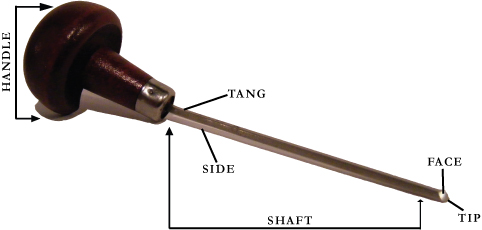Burin (engraving)

A burin (/ˈbjʊərɪn, ˈbɜːr-/ BEWR-in, BUR-) is a steel cutting tool used in engraving, from the French burin (cold chisel). Its older English name and synonym is graver.
Design[]
The burin consists of a rounded handle shaped like a mushroom, and a tempered steel shaft, coming from the handle at an angle, and ending in a very sharp cutting face.
The most ubiquitous types have a square or lozenge face, a high-end repertoire has many others. A tint burin consists of a square face with teeth, to create many fine, closely spaced lines. A stipple tool allows for the creation of fine dots. A flat burin consists of a rectangular face, and is used for cutting away large portions of material at a time.
Uses[]

An engraving burin is used predominantly by intaglio engravers, but also by relief printmakers in making wood engravings. Usually an engraver will have several tools, of different sizes and shapes of cutting face.
It is held at approximately 30° to the surface. The index and middle finger guides the shaft, while the handle is cradled in the palm. The 16th-century Flemish engraver Hendrik Goltzius showed adept use as he found his unusually formed hand was well-suited for its cradling and guiding.
References[]
- ^ Rostow, Alexia. "Porcuprints-Printmaking". Retrieved 2011-08-06.
External links[]
![]() Media related to Burins at Wikimedia Commons
Media related to Burins at Wikimedia Commons
- Printmaking
- Chisels